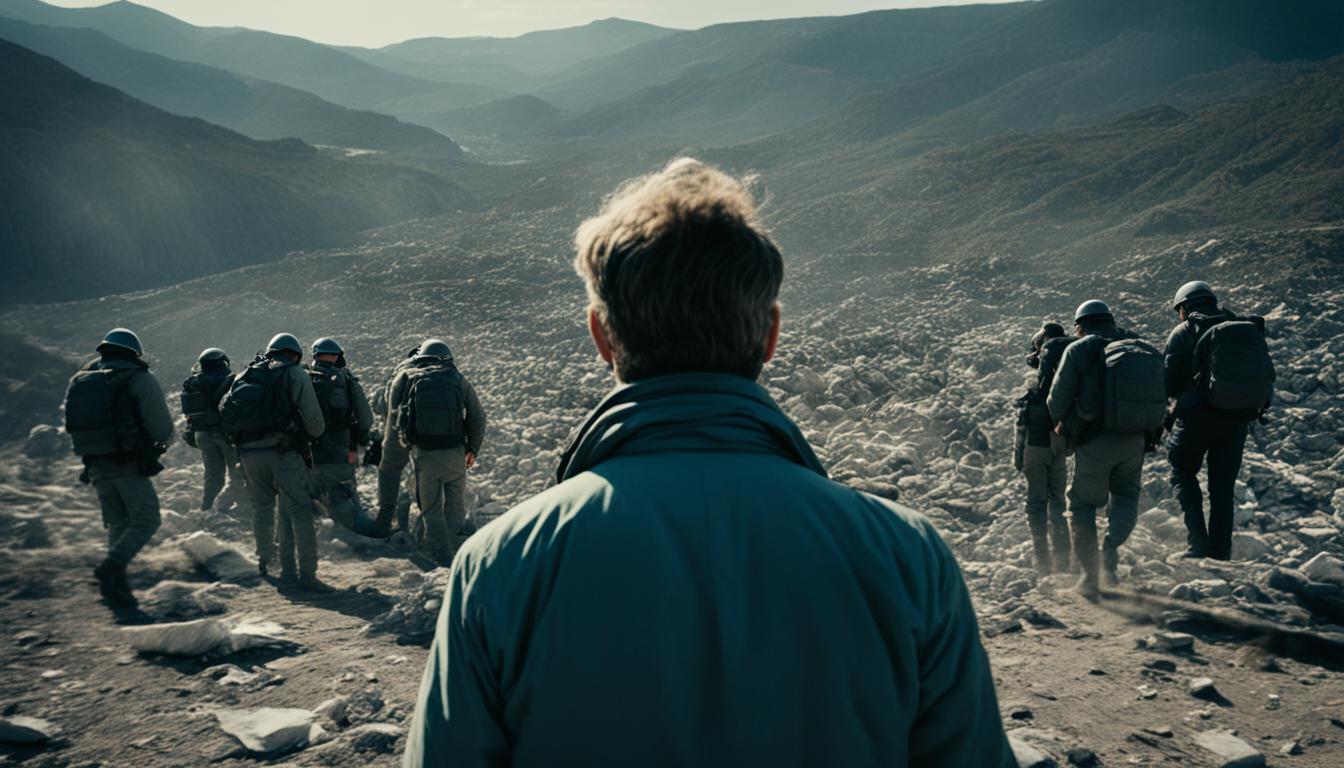Welcome to our in-depth exploration of the world of documentary filmmaking. In this article series, we will delve into the keys to developing long-term documentary projects that captivate and inspire. Whether you’re an aspiring filmmaker or a seasoned veteran, we invite you to join us on this journey to unlock the secrets behind crafting enduring documentaries.
Documentary filmmaking is a unique and challenging endeavor that requires a combination of artistic vision, storytelling prowess, and technical expertise. From concept development to production and distribution, each step in the filmmaking process contributes to the creation of impactful stories that resonate with audiences.
Throughout this series, we will explore various aspects of documentary filmmaking, including the importance of telling stories you believe in, prioritizing self-service for long-term success, and embracing constructive friction in the filmmaking process. Together, we will discover how to navigate the intricate world of documentary production and create projects that leave a lasting impression.
So, whether you’re a filmmaker searching for guidance or simply a documentary enthusiast curious about the behind-the-scenes process, we’re here to provide you with insights and strategies that will elevate your understanding and appreciation of this captivating medium.
Join us as we embark on this exciting journey into the heart of documentary filmmaking, as we learn how to develop long-term documentary projects that make a difference.
Key Takeaways:
- Documentary filmmaking requires passion, dedication, and a deep connection to the stories being told.
- Developing long-term documentary projects involves a combination of artistic vision and strategic planning.
- Embracing constructive friction can lead to creative growth and enhance the quality of your documentaries.
- Prioritizing self-service is essential for long-term success in the documentary filmmaking industry.
- Documentaries have the potential to generate revenue and support the missions of non-profit organizations.
Telling Stories You Believe In: The Heart of Documentary Filmmaking
At the core of successful documentary filmmaking lies the desire to share meaningful stories that align with our values.
We believe that storytelling in documentaries is a powerful tool that can inspire, educate, and create positive change. By focusing on stories that ignite our passion and reflect our authentic voice, we create work that resonates with our audience on a deeper level.
Documentary storytelling is not just about presenting facts or information; it’s about connecting with people emotionally and allowing them to see the world through a different lens. It’s about telling stories that matter.
“Documentaries have the power to awaken empathy, challenge perceptions, and spark conversations that can lead to real change.”
When we tell stories we believe in, we are able to convey our genuine enthusiasm and commitment to the subject matter. This authenticity shines through in our work and captures the attention of our audience.
Strategies for Project Development
Developing a compelling documentary project requires careful planning and project development. Here are some strategies to ensure that our documentaries have a lasting impact:
- Research: Thoroughly research our chosen subject matter to gain a deep understanding of the topic and identify compelling narratives.
- Identify the Story Arc: Determine the key elements of our story, including the main characters, conflicts, and resolution. This will help us create a captivating narrative structure.
- Storyboarding: Visualize our documentary by creating a storyboard that outlines the sequence of shots, scenes, and transitions. This will guide our filming and editing process.
- Interviews and Testimonials: Conduct interviews with experts, subjects, or individuals affected by the topic to gather firsthand accounts and authentic perspectives.
- Visual Storytelling: Utilize cinematic techniques, such as beautiful visuals, compelling cinematography, and thought-provoking imagery, to enhance the storytelling experience.
By implementing these strategies, we can develop documentaries that engage our audience emotionally, intellectually, and visually. Our goal is to craft stories that leave a lasting impression and inspire action.
Prioritizing Self-Service for Long-Term Success
While making a living from documentary filmmaking is important, we understand the need to prioritize self-service for long-term success. Our creative needs and artistic development lay the foundation for a fulfilling and enduring career in this industry. Let’s delve into the key aspects of documentary project management and explore how to strike a balance between commercial interests and our personal creative fulfillment.
In the world of documentary filmmaking, managing our projects efficiently is crucial to ensure smooth operations and achieve our goals. Let’s take a closer look at the fundamental pillars of effective documentary project management:
- Planning: Creating a comprehensive plan lays the groundwork for success. This includes defining project objectives, outlining timelines, and identifying resources needed.
- Budgeting: Managing finances is essential to keep our projects on track. By developing a realistic budget, we can allocate resources wisely and avoid financial setbacks.
- Team Collaboration: Building a strong and cohesive team is vital for successful documentary filmmaking. Collaboration and effective communication among team members foster creativity and ensure a smooth workflow.
- Research and Development: Conducting thorough research and continuously honing our skills broadens our knowledge and enhances the quality of our documentaries. Staying up-to-date with industry trends helps us create engaging and relevant content.
- Time Management: Time is a valuable asset in documentary project management. By implementing effective time management strategies, we can meet deadlines, remain organized, and maintain productivity throughout the production process.
Striking the Perfect Balance
As documentary filmmakers, we often find ourselves navigating the fine line between commercial interests and personal creative fulfillment. While it is essential to consider the financial aspects of our projects, we must not compromise our artistic integrity. By striking the perfect balance between these two elements, we can successfully execute our vision while creating documentaries that resonate with audiences.
It is important to remember that long-term success in documentary filmmaking is not solely determined by financial gains. By prioritizing self-service, nurturing our creative needs, and staying true to our artistic vision, we create work that stands the test of time and leaves a lasting impact.
“The key to success in documentary filmmaking lies in effectively managing our projects while staying true to our creative vision.” – [Filmmaker Name]
Next, we will explore the significance of embracing constructive friction in the filmmaking process, highlighting how it can propel our documentaries to new heights. But before we move on, let’s take a moment to visualize the key aspects of documentary project management in the table below:
| Aspects of Documentary Project Management | Description |
|---|---|
| Planning | Creating a comprehensive project plan with defined objectives and timelines. |
| Budgeting | Managing finances and allocating resources effectively. |
| Team Collaboration | Fostering collaboration and effective communication among team members. |
| Research and Development | Continuously expanding knowledge and honing skills for impactful storytelling. |
| Time Management | Implementing strategies to meet deadlines and maintain productivity. |

Embracing Constructive Friction in the Filmmaking Process
Friction is an inherent part of the filmmaking process. It can be both a catalyst for growth and a potential hindrance. As documentary filmmakers, we understand the importance of embracing constructive friction and utilizing it to our advantage.
When faced with differing opinions or creative conflicts, it is crucial to approach them with an open mind. Constructive friction allows us to challenge our ideas, question our assumptions, and refine our storytelling techniques.
One strategy to embrace constructive friction is to seek feedback from trusted collaborators and fellow filmmakers. Engaging in meaningful discussions about our work can help us see different perspectives, identify blind spots, and uncover new insights.
“Friction is necessary. Without friction, there would be no change, no growth. Embrace it, learn from it, and watch your filmmaking craft evolve.”
Staying committed to our vision, even in the face of criticism, is essential for creating impactful documentaries. While it’s important to remain open to feedback, we must also trust our instincts and stay true to our storytelling approach.
Remember, the filmmaking process is a journey of constant learning and growth. Embracing constructive friction allows us to evolve our ideas, challenge ourselves creatively, and ultimately create documentaries that resonate with audiences on a profound level.
Benefits of Embracing Constructive Friction in Filmmaking
- Enhanced creativity: Constructive friction sparks new ideas and pushes us to explore different storytelling techniques, resulting in more compelling documentaries.
- Improved problem-solving: Interacting with diverse perspectives helps us identify and overcome obstacles, leading to more effective solutions.
- Deeper insights: Embracing friction allows us to dive deeper into our subjects, uncovering hidden layers and presenting a richer narrative.
- Growth as filmmakers: By challenging our comfort zones, we expand our skills, broaden our horizons, and become more versatile and accomplished filmmakers.
Conclusion
In this article, we have explored the keys to developing long-term documentary projects that leave a lasting impact. By telling stories you believe in, prioritizing self-service, and embracing constructive friction, you can craft documentaries that resonate deeply with your audience. These foundational principles are crucial for documentary filmmakers seeking to create enduring and meaningful work.
We have also touched upon the potential of documentary filmmaking as a revenue stream for non-profit organizations. When approached strategically, documentaries can generate income while supporting the organization’s mission. Documentary funding can be obtained through various channels, such as grants, partnerships, and crowdfunding campaigns, providing the financial support necessary to bring your vision to life.
It’s essential to remember that financial sustainability requires careful planning, expert storytelling, and effective marketing. By leveraging your storytelling expertise and implementing innovative distribution strategies, you can position your documentaries as profitable ventures in the ever-evolving media landscape. When successful, these documentaries not only bring in revenue but also contribute to the overall mission and impact of your organization.
As you embark on your journey as a documentary filmmaker, remember that the key to long-term success lies in your dedication to telling compelling stories, managing your projects effectively, and embracing the challenges of the filmmaking process. With passion, persistence, and a focus on both creativity and financial planning, you can create enduring documentaries that leave a lasting mark on the world.
FAQ
What is the key to developing long-term documentary projects?
The key to developing long-term documentary projects is to tell stories you believe in and that reflect your authentic voice. By focusing on stories that ignite your passion, you create work that resonates with your audience on a deeper level.
How important is storytelling in documentaries?
Storytelling is essential in documentaries as it helps engage and connect with the audience. It allows filmmakers to convey their message effectively, evoke emotions, and create a lasting impact.
How can I effectively manage a documentary project?
Effective documentary project management involves balancing commercial interests and personal creative fulfillment. By prioritizing self-service and carefully planning the project’s development, you can ensure long-term success.
What role does constructive friction play in the filmmaking process?
Constructive friction can be both a catalyst for growth and a potential hindrance in the filmmaking process. Embracing it allows for the evolution of ideas and the improvement of craft, leading to impactful documentaries.
Can documentaries be a revenue stream for non-profit organizations?
Yes, when done strategically, documentaries can generate income and support the mission of non-profit organizations. With storytelling expertise and effective marketing, documentaries can be profitable ventures that contribute to financial sustainability.
How Does Multimedia Enhance the Endurance of Documentary Projects?
Multimedia plays a crucial role in extending the endurance of documentary projects. By incorporating various forms of media like videos, images, and infographics, a documentary can engage and captivate audiences for a longer duration. This diverse approach helps to keep the content fresh and relevant, ultimately enhancing the longevity of the documentary project.
Source Links
- https://www.learndocumentary.com/blog/crafting-a-fulfilling-filmmaking-career-the-importance-of-authentic-storytelling-and-staying-true-to-your-vision
- https://www.getstorysmart.com/filmmaking-for-funds-turning-your-non-profit-s-documentary-into-a-revenue-stream
- https://www.getstorysmart.com/show-me-the-money




